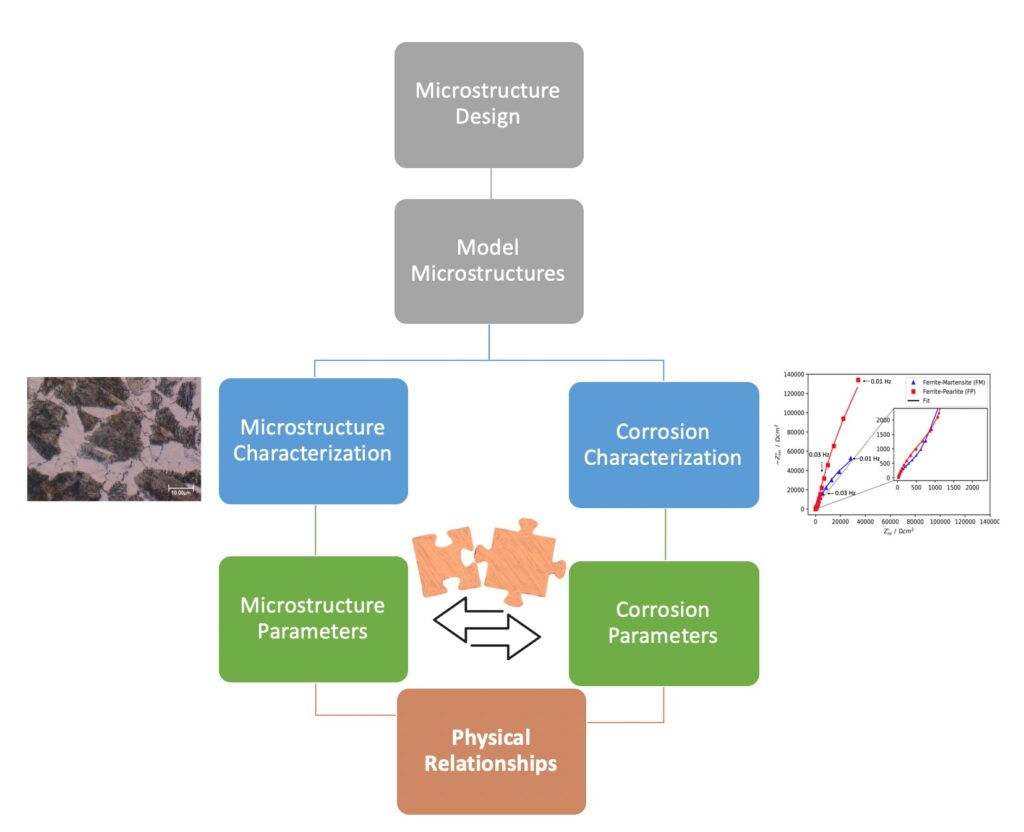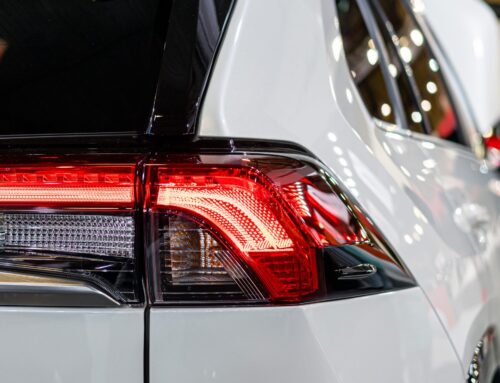Project Description
Key information
Project in the Spotlight: F41.3.14546a
Market: Advanced Metals
Written by: dr.ir. Aytac Yilmaz, dr. Yaiza Gonzalez-Garcia, dr. Viktoria Savran
Introduction
Corrosion is a tremendously important issue in the use of metals. It is estimated that the global cost of corrosion is around €2.37 trillion, equivalent to roughly 3.4 percent of the global Gross Domestic Product (GDP). Implementing corrosion prevention best practices could result in a safe environment and global savings of between 15-35 percent of the cost of damage, €380-850 billion (NACE 2016). Yet, although corrosion has been widely investigated, there is still an essential lack of understanding of the influence of microstructural features on the corrosion process in ferrous alloys. In the past decades, great advances have been achieved in the understanding of the microstructure-strength relations, but the knowledge of microstructure-corrosion relations is much less. This is mainly due to the complex interaction of many microstructural features on corrosion and passivation (the protective oxide formation that limits the progress of corrosion) behaviour of ferrous alloys. The lack of knowledge on the corrosion-microstructure relationship leads to the excessive applications of corrosion protection methods such as coatings, plating, inhibitors, etc. These corrosion protection methods are widely applied and often bring health, safety and environmental issues. Moreover, they increase the costs in many industries.
Therefore, accomplishing adequate corrosion resistance in metals through the microstructure-corrosion relations is crucial. To enable the identification of relations between microstructure and corrosion on a scale and degree of detail that was not been reached before, this project combined expertise on metallic microstructures with expertise on localized corrosion and electrochemistry. The schematic of the overall research approach is given in the figure below.

Figure. Schematic representation of the multidisciplinary approach taken to establish relationships between microstructural features and corrosion behaviour
To study the sole effect of several microstructural features (grain size, dislocation density, crystallographic orientation and phases) on corrosion and passivation behaviour, model microstructures were used. Within these model microstructures, a single microstructural feature was manipulated at a time through heat treatments and thermomechanical processes. The obtained microstructures were analysed with dilatation response, Scanning Electron Microscopy (SEM), optical microscopy and X-Ray Diffraction (XRD). The effect of each microstructural feature on corrosion and passivation behaviour was investigated through (local) electrochemical (e.g. Electrochemical Impedance Spectroscopy (EIS), polarization, in-situ Atomic Force Microscopy (AFM)) and surface (e.g. X-ray Photoelectron Spectroscopy (XPS), Scanning Kelvin Probe Force Microscopy (SKPFM), Scanning Electron Microscopy (SEM), Atomic Force Microscopy (AFM)) techniques.
This allowed us to understand the effect of each above-mentioned microstructural feature on corrosion and passivation behaviour. Our findings show how each microstructural feature (grain size, dislocation density, crystallographic orientation and phases) affects the corrosion and passivation behaviour. Moreover, we show the dominancy order of microstructural features on the corrosion and passivation behaviour. The results obtained in this project significantly deepen the scientific knowledge of the microstructure-corrosion relationship. This opens the possibility of taking the corrosion properties into account while designing the microstructure of alloys. Previously, the mechanical properties were mostly considered in the microstructure design. The newly developed knowledge on the basics of corrosion and passivation will be implemented on their products by Tata Steel, the main project partner. Moreover, the project findings reduce the application of corrosion protection methods in many industries, ranging from construction and packaging to aviation and energy. This will not only diminish the environmental, safety, and health concerns stemming from the nature of corrosion protection methods but also prevent additional corrosion protection costs.
The project F41.3.14546a got NWO-FOM funding in 2016-2021 The project was performed by Aytac Yilmaz under the supervision of dr. Yaiza Gonzalez-Garcia and prof. Jilt Sietsma at TU Delft (Materials Science and Engineering department) in cooperation with dr. Erdni Batyrev and dr. Berend Boelen from Tata Steel.
While designing metal alloys, microstructure has been primarily considered for optimizing the mechanical properties. This is mainly due to well-established relationships between microstructure and mechanical properties. The microstructure and corrosion properties relationship has been overlooked due to the lack of knowledge of this relationship in the design of alloys. Yet, corrosion is a significant challenge to many industries, limiting the lifetime of alloys, bringing safety issues, and increasing costs.
The multidisciplinary research approach of MICROCORR project, combining microstructure and electrochemistry, permitted overcoming the difficulties in identifying the sole role of microstructural features on corrosion behaviour.
The established relationships between microstructure and corrosion relationships in the project laid the foundations for optimizing the mechanical and corrosion properties of metal alloys simultaneously while designing the alloys’ microstructure. To a certain degree, deepening the knowledge further can prevent the application of corrosion protection methods which may bring safety and health issues, extra costs, design limitations and more.
I am glad to work on shedding light on such an important research question for a scientific and industrial committee. I am very grateful to receive the incredible supervision of Prof. Jilt Sietsma on microstructure perspective and Assoc. Prof. dr. Yaiza Gonzalez-Garcia on electrochemistry, which leads to fruitful results in the project. Also, the close collaboration with the scientists at Tata Steel facilitated the scientific research and directed the project in line with the industrial needs.
 Dr. Erdni Batyrev (Tata Steel)
Dr. Erdni Batyrev (Tata Steel)
Steel is an essential material for society, and it is crucial as an infrastructure enabler in the technological transition to a low carbon economy. Therefore, preventing steel corrosion is of great importance in view of safety and economic reasons. The gained knowledge in the surface reactivity of various steel grades will definitely help Tata Steel to better understand the corrosion mechanisms and to tailor the steel microstructure of their coated advanced high strength steels accordingly that can withstand the corrosion more efficiently. We are very happy with the learnings of this study and Aytac’s development as a scientist.
 Dr. Yaiza Gonzalez-Garcia (TU Delft)
Dr. Yaiza Gonzalez-Garcia (TU Delft)
Finding the relationship between corrosion resistance of steel and its microstructure will allow us, to a certain degree, to control the life-service of the steel already from the design and processing stage.
MICROCORR is a pioneering research project where corrosion, electrochemistry and metallurgy experts joined forces to study this correlation. The results from this project provided scientific insight into the influence of microstructural defect density and grain sizes on the corrosion of engineering steels. These findings are highly relevant to the scientific community and our industrial partner Tata Steel.
I am delighted with the outcome of this project and the collaborations between the research, industrial team, M2i and NWO. The PhD work carried out by Aytac highlighted the importance of a systematic design of model microstructures to understand the steel’s corrosion performance.
A crucial difficulty in using materials in applications is that a single material should fulfill a broad range of requirements. For metals, these requirements are in the majority of cases primarily concentrated on the mechanical behaviour, which is always important. But at the same time the long-term performance, relating to costs, resource efficiency and safety, are to be considered when designing the composition and microstructure of metals. Fatigue (again, mechanical behaviour…) and corrosion are the dominant processes determining the performance of metallic components. The MICROCORR project has accomplished a fantastic step forward towards designing metallic microstructures in a more holistic way, involving both instantaneous properties and long-time performance, specifically in relation to corrosion.
The matter is not fully solved; that is impossible in a single project. But the approach and the results show that this type of research leads towards improved design of microstructures, serving material efficiency, safety and sustainability.
This project has also been a great example of the collaboration, in a perfectly complementary manner, between academia, industry, M2i and funding agency NWO. Tata Steel scientists have been closely involved in the research and contributed to the science, with a distinct eye on application possibilities.
But the most important result of this project is dr. Aytac, a young scientist who will contribute much more to optimising materials for sustainability in his future career.




